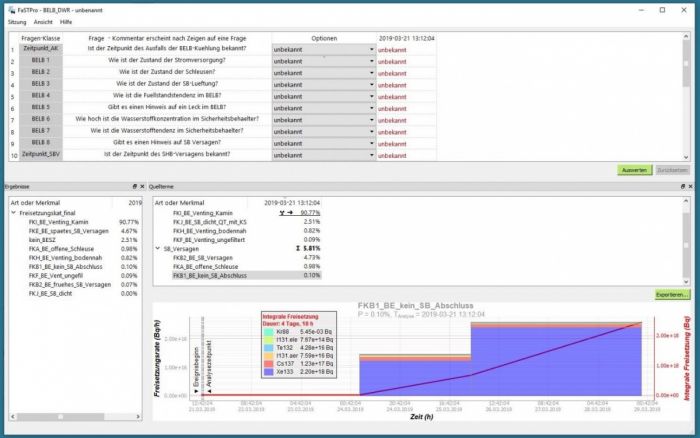FaSTPro: Fast Source Term Prognosis
The FaSTPro code uses the data of the Probabilistic Safety Analysis (PSA) of the respective plant to determine source terms. In German plants, a PSA is performed every 10 years as part of the periodic safety reviews. To put it simply, a source term is defined in a PSA for every possible accident sequence that will cause damage to the reactor core. The PSA indicates the probability with which the respective accident sequence will occur. In addition to the information from the PSA, the code uses plant data such as pressure or temperature for its source term calculations.
In practice, the determination of source terms then looks like this: The user of the code is asked to provide various pieces of information about the system status or to answer questions about it. These questions may be: "Time of reactor scram?" or "How high is the currently measured coolant pressure?” A scroll-down menu allows the user to click on the correct answer for his plant, using the multiple-choice method (see Figure 1). When querying data, questions can also remain unanswered or be marked "not known" if, for example, measurement displays have failed or if there is contradictory information about the values. These missing answers are replaced by the respective PSA data for the further calculation.
In a further step, the plant data are compared with the PSA data. If the plant data show, for example, that the pressure in the reactor drops below 9 bar within 200 seconds and radioactivity is measured, the system will indicate a possible loss-of-coolant accident when comparing the data with those from the PSA and will then indicate the probability of occurrence of such an event. In this way, the number of possible accident sequences and thus also the source terms in question can be limited on the basis of the existing plant data. The processing time until the user has a selection of possible source terms at his disposal takes only a few seconds. In addition, the relatively simple use in the stress situation of an accident can help to prevent wrong decisions.
The joining of the plant data determined in each case with the PSA data is carried out on the basis of a so-called Bayesian network. The special feature of such a network is that it can infer an effect not only from a cause, but also in the opposite direction. In our case, the network can therefore not only infer the effect of "core damage" from the cause "loss of coolant with simultaneous failure of safety systems" but can also in reverse infer possible causes for the malfunction from the parameters observed in the system and provide them with a probability of occurrence. Figure 3 shows the concept in a simplified manner.
What is the logic behind?
GRS already developed a first version of the FaSTPro code back in 2008 as part of a project sponsored by the Federal Environment Ministry and the Federal Office for Radiation Protection (BfS). Since then, the GRS code has been continuously developed and, for example, adapted from the original variant for pressurised water reactors for application to boiling water reactors. Currently, five of the seven German plants still in operation use the GRS code. In its "Recommendation on the Forecast and Estimation of Source Terms in the Event of Nuclear Power Plant Accidents", the Commission on Radiological Protection generally recommends the use of computer-aided probabilistic methods for source term prognosis. GRS itself uses FaSTPro in its Emergency Centre, which also supports the Federal Radiological Situation Centre.
